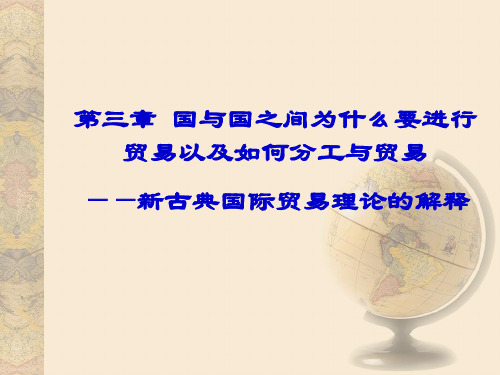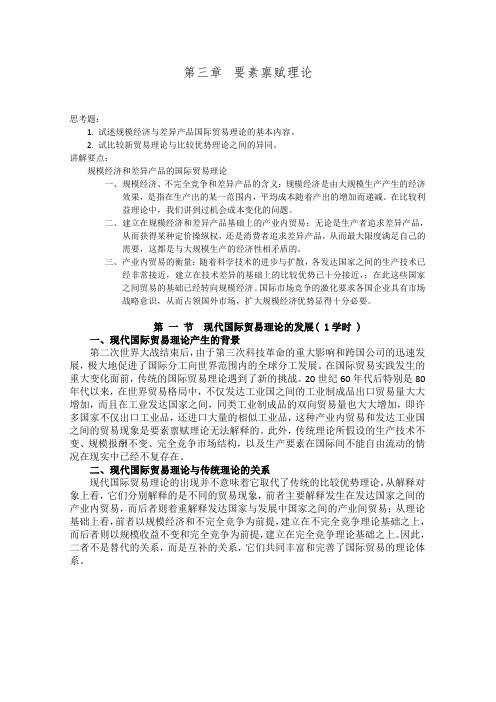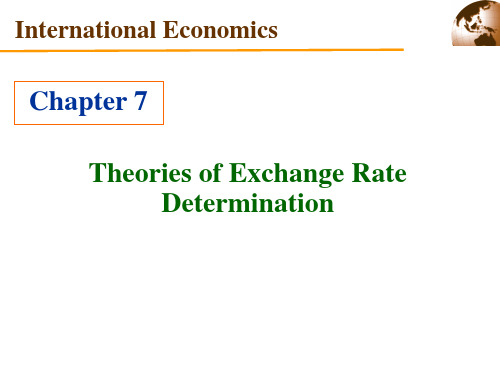国际经济学 黄敏 第三章
国际经济学第3章-PPT课件

3.7 小结 词汇
• 1、有关贸易模式最重要的决定因素是生产 可贸易品的机会成本。
• 2、亚当·斯密绝对利益学说的基本概念与内 容。在某一种商品上,一个经济在劳动生 产率上占有绝对优势,或其生产所耗费的 劳动成本绝对低于另一经济,若各个经济 都从事自己占有绝对优势商品的生产,继 而进行交换,那么双方都可以通过交换得 到绝对的利益,从而整个世界也可以获得 分工的好处。
• 4、假设德国准备在香焦生产上自给自足,甚至出口。为 了完成这些目标,政府给予那些复香焦生产进行投资的企 业以税收激励。很快,德国的香焦业变得有竞争力且可以 在世界任何地方以最低价格销售。德国具有比较优势吗? 为什么?对于德国整体经济的后果是什么?
第二部分 国际贸易
• 阿里巴巴赴美上市 马云成中国新首富(南方都市报 )
4件 B国(3时 2单位时 1单位时 间总量) 间/件 间/件
A国(3时 间总量)
3件
0
6件
B国(3时 间总量)
0
3件
绝对利益说结论
• 绝对利益学说的基本概念与内容。在某一 种商品上,一个经济在劳动生产率上占有 绝对优势,或其生产所耗费的劳动成本绝 对低于另一经济,若各个经济都从事自己 占有绝对优势商品的生产,继而进行交换 ,那么双方都可以通过交换得到绝对的利 益,从而整个世界也可以获得分工的好处 。
教材第37页指出:
• 重商主义:18世纪统治整个经济思想的国 民经济体系。强调出口的作用大于进口, 将出口作为获取军队和国家建设项目资金 的主要方式。
• 国家经济主义:重商主义在今天的表现和 发展。
• 它们的主要错误:认为贸易是一种零和博 弈。
3.1.2生产和贸易的简单模型
• 亚当·斯密模型和大卫·李嘉图模型 • 假设:1、两个国家、两种产品、一种投入
国际经济学[3]PPT课件
![国际经济学[3]PPT课件](https://img.taocdn.com/s3/m/04d105dd7cd184254a35359c.png)
而获得了一个经济学家所能获得的所有荣誉:第一
个克拉克奖章获得者(1947年);第二个诺贝尔经
济学奖获得者(1970年);他曾是美国经济学会会
长(1961年),经济计量学会会长(1951年),国
际经济学会会长(1965——1968年)以及其他许许
多多奖励和荣誉。
2021/2/8
-
42
萨缪尔森为人谦逊,曾把前辈们比喻为 牵引他的火车头。他学识渊博,精通经济学、 数学、历史等,是第一个对经济学进行定量 分析的经济学家,并对其他学科也有自己独 到的见解。萨缪尔森充满活力、才华横溢, 到1938年发表的文章数量达到每年5篇,这 样断断续续地维持了半个世纪。
1919年,赫克歇尔发表了题为《国际贸易对收入分配的影响》的论文,
1933年,俄林出版了著名的《区域贸易与国际贸易》一书。
2021/2/8
-
3
一、两个基本概念
(一)要素禀赋(fa度,是指一国所拥有的两 种生产要素的相对比例。 判断一国要素禀赋有两种方法:
2021/2/8
-
24
思考题
1.要素禀赋的差异会使两国的生产可能性曲线的 形状不同。
(1)还有什么其他因素会导致两国的生产可能性曲 线有不同的形状?
(2)在赫_俄模型中,赫和俄做了哪些假设来防止 (1)中的情形发生?
(3)在无贸易条件下,还有什么其他可能的原因会 导致两国相对商品价格产生差异?
2021/2/8
2021/2/8
Paul A. Samuelson,
-
1915-2009
41
人物介绍:萨缪尔森(Paul Anthony Samuelson,1915-)
萨缪尔森于1915年出生于美国印第安纳州,获
国际经济学黄敏第二章

indicates that workers may be better or worse off, depending on preferences; It predicts that owners of factors used in export industries gain from trade, while owners of factors used in import-competing industries will lose from trade.
2.2 Factor Endowment Theory (H-O Model)
Wheat
France’s PPF
Wheat
France’s PPF
21 15
F G II Ⅰ tG tF
30 20 10
F’ F H G G’ II Germany’s PPF
Germany’s PPF t1 0 14 20 Auto 0 6 18 30 Auto
can move between machine production and cloth production over time. Such as labor in the model.
mobile factor
It
2.1 Specific Factor Model
Wage Rate Wage Rate
2.1 Specific Factor Model
2.2 Factor Endowment Theory (H-O Model) 2.3 Other New Classical Theories 2.4 Leontief Paradox
2.1 Specific Factor Model
国际经济学第三章

第三节 凯恩斯主义的 贸易保护观点
一、凯恩斯的贸易保护观点
《就业利率与货币通论》
1、在开放经济条件下,奖励 出口、限制进口是一国总需求政策 的一部分; 2、政府干预、保护贸易收支 顺差不是一个长期目标,而只是在 一国有效需求不足的情况下才偶尔 使用的手段。
二、后凯恩斯主义的贸易保护 观点
保护贸易收支顺差不仅能够在 理论上扩大本国的有效需求,而且 能够以乘数的形式增加总收入。
保护贸易理论的主要观点是: 由于国际贸易发展的不平衡,国家 经济结构的差异性,各国可采取限 制进口的措施和鼓励出口的政策, 保护本国市场,扩大出口市场,维 护本国的产业结构。
第一节
保护关税说
保护关税说又称制造业保护论, 是由美国金融学家汉密尔顿 (Alexander Hamilton)于1791年在 向国会递交了一份题为《关于制造 业的报告》(Report on Manufacture) 中提出的。
三、凯恩斯主义的贸易保护理论 简评
凯恩斯主义的贸易保护理论反 映了西方经济由单纯重视企业的经 济运行向重视宏观经济稳定和增长 方向的转变。
1 1、向私营工业发放贷款,扶 持私营工业发展; 2、实行保护关税制度,保护 国内新兴工业; 3、限制重要原料出口,免税 进口本国急需原料;
4、给各类工业发放奖励金,并 为必需品工业发放津贴; 5、限制改良机器及其他先进 设备输出;
6、建立联邦检察制度,保证 和提高工业品质量; 7、吸收外国资金,以满足国 内工业发展需要; 8、鼓励移民迁入,以增强国 内劳动力供给。
(1)原始未开化时期;
(2)畜牧业时期; (3)农业时期:应实行自由贸 易政策; (4)农工业时期:实行保护贸 易政策; (5)农工商时期:应实行自由 贸易政策。
国际经济学课件第三章

二.如果两国之间不存在比较优势,两国之间绝不 会发生贸易。( )
25
根据贸易理论,如果两国的国内市场规模存在差异, 而其他条件完全相同,那么国内市场规模相对较大的 国家将完全专业化生产具有外部规模经济的产品X, 而国内市场规模较小的国家将只能完全专业化生产规 模收益不变的产品Y 。( )
21
三、标准产业内贸易指数
Ti=1- ———————— Xi和Mi代表某特定产业中特定产品的出口额和进口额 X和M代表某国家的出口总额和进口总额 Ti=0,不存在产业内贸易 Ti=1,存在最大化的产业内贸易
○ ∑│(Xi/X)-(Mi/M)│ ○ ∑│(Xi/X)+(Mi/M)│
22
表2.8 1993年
15
封闭条件 下
一般均衡点在图中的E点,在E点相对价格 线(Px/Py)与生产可能性边界相交,而 不是相切,这是因为X部门存在外部规模 经济,所以X部门厂商所面对的相对价格 要高于社会机会成本(生产可能性边界的 切线斜率的绝对值)。在均衡状态时,社 会福利则由通过E点与相对价格线相切的 社会无差曲线表示。
在封闭条件下当达到均衡时,两国的相对价格完全一致,即不存在比较优势。
14
图6-1
部门间要素密集度的差异会 产生一种将生产可能性边界 向外凸的“张力”,而规模 经济则生产一种将生产可能 边界向内凹(机会成本递减) 的“吸力” 。假设规模经济 的影响超过了要素密集度的 影响,生产可能性边界的形 状是一条凹向原点的曲线 TT‘。
来自于实践的经验积累就比较显著了,因此,行业内每个企业都可从整个行业的规模扩 大中获得更多的知识积累。
国际经济学教程(第三版)第三章 国与国之间为什么要进行贸易以及如何分工与贸易

• 戈特哈德·贝蒂·俄林(Bertil Gotthard Ohlin,1899--1979) 瑞典著名经济学家
二、要素禀赋理论的相关概念与分析工具
1、要素禀赋(Factor Endowment)与要素丰裕 度(Factor abundance) 要素禀赋是指一国所拥有的两种生产要素(劳 动和资本)的相对比例,这是一个相对的概念, 与其所拥有的生产要素绝对数量无关。
二、赫—俄理论(H-O理论)的主要结论
1、区域贸易或国际贸易的直接原因是价格差别, 即各个地区或国家间商品价格的不同。
2、每个区域或国家在国际分工和国际贸易中应 该生产并输出丰裕要素密集的商品,输入稀缺 要素密集的商品。
3、商品贸易趋向于(即使是部分地)消除工资、 地租、利润等生产要素收入的国际差别,导致 国际间商品价格和要素价格趋于均等化。
• 英籍波兰经济学家罗伯津斯基在H-O定理的基 础上提出了罗伯津斯基定理(Rybczynski Theorem),阐述了一国要素禀赋的变化对该 国产出及国际贸易的影响。
(一)罗伯津斯基定理(Rybczynski Theorem)
在商品相对价格不变的前提下,一种生产要素增加会 导致密集使用该要素的产品产出增加,而密集使用其 它要素的产品产出减少。
Y
如图,A国在要素增长之前,在Y商品
具有比较优势,因此在开始阶段出口
Y,进口X。但由于要素增长偏向X部
门,最终比较优势由Y商品转移到X商
品,A国也变为出口X,进口Y。
O
ห้องสมุดไป่ตู้
X
历史上,美国经济的发展就是这方面的典型。在1920年以前, 美国在土地密集型产品具有比较优势;之后,随着要素积累, 劳动和资本密集型产品变得具有比较优势。
《国际经济学》黄卫平版 第三章 要素禀赋理论

第三章要素禀赋理论思考题:1. 试述规模经济与差异产品国际贸易理论的基本内容。
2. 试比较新贸易理论与比较优势理论之间的异同。
讲解要点:规模经济和差异产品的国际贸易理论一、规模经济、不完全竞争和差异产品的含义:规模经济是由大规模生产产生的经济效果,是指在生产出的某一范围内,平均成本随着产出的增加而递减。
在比较利益理论中,我们讲到过机会成本变化的问题。
二、建立在规模经济和差异产品基础上的产业内贸易:无论是生产者追求差异产品,从而获得某种定价操纵权,还是消费者追求差异产品,从而最大限度满足自己的需要,这都是与大规模生产的经济性相矛盾的。
三、产业内贸易的衡量:随着科学技术的进步与扩散,各发达国家之间的生产技术已经非常接近,建立在技术差异的基础上的比较优势已十分接近,;在此这些国家之间贸易的基础已经转向规模经济。
国际市场竞争的激化要求各国企业具有市场战略意识,从而占领国外市场,扩大规模经济优势显得十分必要。
第一节现代国际贸易理论的发展( 1学时 )一、现代国际贸易理论产生的背景第二次世界大战结束后,由于第三次科技革命的重大影响和跨国公司的迅速发展,极大地促进了国际分工向世界范围内的全球分工发展。
在国际贸易实践发生的重大变化面前,传统的国际贸易理论遇到了新的挑战。
20世纪60年代后特别是80年代以来,在世界贸易格局中,不仅发达工业国之间的工业制成品出口贸易量大大增加,而且在工业发达国家之间,同类工业制成品的双向贸易量也大大增加,即许多国家不仅出口工业品,还进口大量的相似工业品,这种产业内贸易和发达工业国之间的贸易现象是要素禀赋理论无法解释的。
此外,传统理论所假设的生产技术不变、规模报酬不变、完全竞争市场结构,以及生产要素在国际间不能自由流动的情况在现实中已经不复存在。
二、现代国际贸易理论与传统理论的关系现代国际贸易理论的出现并不意味着它取代了传统的比较优势理论。
从解释对象上看,它们分别解释的是不同的贸易现象,前者主要解释发生在发达国家之间的产业内贸易,而后者则着重解释发达国家与发展中国家之间的产业间贸易;从理论基础上看,前者以规模经济和不完全竞争为前提,建立在不完全竞争理论基础之上,而后者则以规模收益不变和完全竞争为前提,建立在完全竞争理论基础之上。
第三章国际经济学课件

大连理工大学 经济学院
本章内容概要
➢ 标准的国际贸易理论 ➢ 要素禀赋论和赫克谢尔-俄林模型 ➢ 赫克谢尔-俄林理论条件 ➢ 要素禀赋论的检验
一、标准的国际贸易理论
1 封闭经济的一般均衡
▪ 假设某行业典型厂商使用两种生产要素—资本和劳动生 产一种商品,且等产量线具有同位相似性,即从原点出 发的任一射线与等产量线族的交点的切线斜率相等。
➢ 第一,经济社会使用两种生产要素(资本和劳动)生 产两种商品X和Y;
➢ 第二,生产要素在国内自由流动,在国际间不能自由 流动;
➢ 第三,不同国家拥有不同的技术水平,给定各国的技 术水平,且假定规模报酬不变;
➢ 第四,经济体处在充分就业状态下,资源数量固定不 变,商品和劳动市场是完全竞争市场,经济体不存在 外部性(externality)。
MRT XY
MC X MCY
▪ 机会成本递增更符合实际,生产可能性曲线的形成说明
生产契约线
▪ 两个行业等产量线的所有切点S、R、T…连接得到A国 的生产契约线,生产契约线上的任一点代表两行业的边 际技术替代率(或要素价格)相等,资源在两行业间的 流动相对静止,同时两行业的要素投入之和正好等于A 国拥有的资源数量。
▪ 生产契约线上X和Y商品的组合是A国最优生产组合,A 国在生产契约线之外的任何一点生产都是缺乏效率的。
▪ 离OX(或OY)越远的等产量线表示X(或Y)产量越大, 经济体处在充分就业状态,所有资本和劳动被完全分配 在X行业和Y行业中,资源被充分利用。
▪ 完全竞争状态下资源在国内自由流动,当两个行业的要 素价格相同时资源流动处于动态平衡,两行业的生产者 均衡对应的边际技术替代率相等,等产量线相切,经济 体的生产要素配置达到均衡。
《国际经济学(双语)》(黄敏主编复旦大学出版社)讲义第11章

Three points should be noted about this redistribution of the world’s labor force. It leads to a convergence of real wage rates. Real wages rise in Country A and fall in Country B. Country B’s output rises by the area under its marginal product curve from L1 to L2, while Country A’s output falls by the corresponding area under its marginal product curve. Those who would originally have worked in Country A receive higher real wages, but those who would originally have worked in Country B receive lower real wages.
11.1 International Movement of Labor
This change in relative labor supplies will lead Country A to contract production of X from t0 to t1 and expand production of Y from a0 to a1. Country B, on the other hand, will expand production of X from T0 to T1 with the newly acquired labor and reduce the production of Y from A0 to A1.
黄卫平、彭刚《国际经济学教程》第3版配套题库

黄卫平、彭刚《国际经济学教程》第3版配套题库黄卫平、彭刚《国际经济学教程》(第3版)配套题库【考研真题精选+章节题库】目录第一部分考研真题精选一、单项选择题二、多项选择题三、判断题四、名词解释五、简答题六、计算题七、论述题第二部分章节题库第一章绪论第二章古典国际贸易理论第三章国际贸易价格的确定第四章国际贸易的现代与当代理论(Ⅰ)第五章国际贸易的现代与当代理论(Ⅱ)第六章国际贸易政策分析第七章国际收支分析第八章汇率决定理论第九章国际货币危机与国际货币体系第十章要素的国际流动第十一章国际经济非均衡传导第十二章宏观经济的内外均衡第十三章经济一体化与国际经济秩序第十四章经济全球化分析•试看部分内容考研真题精选一、单项选择题1以下哪一项表述是正确的?()[中央财经大学2018研] A.绝对优势理论强调黄金和白银是国家财富的主要支撑,对充满活力的商业是非常重要的B.正和博弈指博弈中一个国家盈利而另一个国家受损C.比较优势理论传达的基本信息是无限制的自由贸易比限制的贸易创造更多的世界生产量D.要素禀赋仅包括各国拥有劳动力和资金资源的程度,而不包括拥有土地的程度【答案】C查看答案【解析】A项,重商主义强调金银的重要性,力图通过奖出限入的措施保证和扩大贸易顺差,以达到金银流入的目的。
B项,正和博弈是指博弈双方的利益都有所增加。
D项,要素禀赋包括各国拥有劳动和土地资源的程度。
2在李嘉图的比较优势论中,国际贸易产生的原因是两国的()。
[北京邮电大学2015研]A.绝对劳动生产率差异B.相对劳动生产率差异C.绝对生产要素禀赋差异D.相对生产要素禀赋差异【答案】B查看答案【解析】李嘉图的比较优势论认为国际贸易的产生不仅在于绝对成本的差异,而且还在于比较成本的差异,比较成本的差异来源于相对劳动生产率差异。
3国际生产折中理论所阐述的跨国公司对外直接投资必须具备的“三个优势”不包括下列哪一项?()[中央财经大学2018研]A.市场竞争优势B.所有权优势C.内部化优势D.区位优势【答案】A查看答案【解析】国际生产折中理论也称国际生产综合理论,是由当代西方研究跨国公司问题的著名专家约翰·邓宁提出的。
经济学国际经济学第三章

The responsiveness of quantity demanded to a change in price depends on the slope of the demand curve—that is, the price elasticity of demand
Welfare Effects of International Trade
➢ –Graphically, it is equal to the area above the supply curve and below the price.
Producer Surplus
A National Market with No Trade
If there is no international trade, equilibrium occurs at the price at which the market clears
International Economics
By Robert J. Carbaugh 9th Edition
Chapter 3: International Equilibrium
The Basic Theory Using Demand and Supply
Demand
Determinations of consumer demands Preferences, Price of the product, Income
Equilibrium Price: $2000 Equilibrium quantity: 40,000 Consumer Surplus: c Producer Surplus: h
《国际经济学(双语)》(黄敏主编复旦大学出版社)讲义第7章

7.3 Balance of Payments Approach
e S’
e1
E1
S
e0
E0
D’ e in P will cause an appreciation of real exchange rate, reduce the competitiveness of home products, decrease exports and the supply of foreign exchange, increase imports and the demand for foreign exchange, and worsen the balance of payments, resulting in a depreciation of domestic currency.
The current account is mainly determined by exports and imports.
C A C A (Y ,Y * ,P ,P * ,e )
The capital and financial account is mainly determined by home interest rate r, foreign interest rate r* and the expectation of future exchange rate.
period.
e1
P1 P1*
P0 P0*
e0
国际经济学课程第三章课件

有效保护率的几种情况
情况三:进口投入品的份额。 当进口投入品占总产品的比例从50%上升 到80%时。 进口皮包40%关税,1400日元,进口皮革 20%关税,960日元,关税结构时的国内增 加值为440日元,自由贸易时的国内增加值 为200日元,保护国内增加值的增加比例为 (440-200)/200=120%
有效保护率的几种情况
案例:日本自由贸易时的皮包价格为1000日元,进口皮革 为500日元,则日本进口皮革生产皮包的国内增加值为 500日元 情况一:当最终产品的关税率超过投入品的关税率时,有 效保护率超过了名义保护率。进口皮包40%关税,1400日 元,进口皮革20%关税,600日元,关税结构时的国内增 加值为800日元,自由贸易时的国内增加值为500日元, 保护国内增加值的增加比例为(800-500)/500=60% 情况二:当投入品的关税率超过最终产品的关税率时,有 效保护率低于名义保护率。进口皮包30%关税,1300日元, 进口皮革40%关税,700日元,关税结构时的国内增加值 为600日元,自由贸易时的国内增加值为500日元,保护 国内增加值的增加比例为(600-500)/500=20%
关税是重要的国内收入再分配方式(静态 效应的总结) 关税增加国内垄断的程度,减少国内企业 竞争精神,其造成了国内福利净损失是不 可估量的。这可以理解为关税国内效应的 动态效应
关税对出口国的影响。在进口国是大国的 条件下,商品出口国的贸易条件恶化,出 口国为进口国部分支付关税,生产商受损, 虽然消费者受益(出口国内该商品价格下 跌),但出口国作为整体受损。
实例: 欧盟的情况:产业内的专业化生产
怎样理解中国-东盟自由贸易区?从现象上看,一些东盟 国家比较紧张,中国国内的宣传也比较少。东盟国家的一 些产业遇到很大的挑战,出现萎缩。怎样评估这个自由贸 易区的净贸易效应?
国际经济学第3章概要

规模经济与规模收益递增: ❖ 后者是指一种纯粹的技术特征,它指生产过程中产 出增加的比例大于要素投入增加的比例。 ❖ 当生产过程遵循规模报酬递增规律时,自然存在规 模经济,但反过来,规模经济并不要求规模报酬递增 一定存在。 ❖ 在外部规模经济情况下,企业的生产过程仍是规模 收益不变的,规模收益递增只发生在产业层次上,即 整个产业增加比例大于整个产业要素投入增加的比例。
(4)产业内贸易的测度
产业内贸易程度可以用产业内贸易指数来测度。计算公式为:
X M
T 1
X M
式中X和M分别代表一个产业或一类产品的出口额和进口额。T
的取值范围介于0和1之间。T愈是接近1,说明产业内贸易程度愈高;
T愈是接近0,则意味着产业内贸易程度愈低。
当T=0时,表示该国在这一产业或这类产品上只有进口或出口,
第3章 现代国际贸易理论
第3章 现代国际贸易理论
3.1 基于需求不同的贸易理论 3.2 产业内贸易理论 3.3 基于动态技术差异的国际贸易理论 3.4 运输成本、环境标准与国际贸易 3.5 外部规模经济与国际贸易
3.1 基于需求不同的贸易理论
假设甲、乙两国在生产方面的能力是完全 相同的,即两国具有相同的生产可能性曲线。 但两国的需求偏好不同,因此在封闭经济条件 下,同一种商品在两国的价格也会有所不同。
二、规模收益递增与国际贸易
以2×2模型为基础,做如下假设:
❖市场结构仍是完全竞争的; ❖ 两国的相同部门的生产函数、要素禀赋、消费者 偏好以及市场规模假设均相同。
在封闭条件下当达到均衡时,两国的相对价 格完全一致,即不存在比较优势。
Y 120 B`
100
80
60
E
Ⅱ
40
国际经济学第三章

• 三、模型基本假设 • 要素禀赋标准模型建立在以下几条基本假设之上: (1)两国相同部门的生产函数相同; (2)两国消费者偏好相同; (3)规模收益不变; (4)所有商品市场、要素市场都是完全竞争的; (5)两国的生产要素供给是既定不变的; (6)假设A国为资本丰富的国家,B国为劳动丰富 的国家; (7)生产要素在一国之内可自由流动,在国际间不 能流动; (8)X、Y的生产技术不同,其中X假设为资本密集 型产品,Y假设为劳动密集型产品; (9)不存在运输成本或其它贸易障碍。 由以上假设可知,A、B两国除要素禀赋不同外,其 它一切条件都是完全相同的。
•
在图3—8中,我们可以这样来确定均衡条件下的要素 价格水平:画一条与X和Y的单位价值等产量曲线都相切 的切线,那么该切线就是单位等成本直线,它在横坐标轴 与纵坐标轴上的截距的倒数,分别对应于劳动、资本的均 衡价格。 在自由贸易下,X、Y两种产品无论在A国还是B国价 格都是相同的,另外两国的生产技术条件也完全相同,所 以两国相应产品的单位价值等产量曲线的形状和位置也完 全相同,从而两国在均衡时的单位成本曲线也完全相当。 实际上, A、B两国在贸易后要素价格的决定均可由图3— 8来描述,于是,贸易后两国的要素价格自然也就相同。
二、国际贸易与要素价格均等化 • 要素价格均等化定理:贸易前,由于两 要素价格均等化定理: 国要素禀赋的差异,所以两国的要素价 格的不一致导致了同种商品价格的不同。 但贸易开始后,两国商品的相对价格的 差异会不断缩小,并最终达到均等,不 仅如此,要素的价格和生产中的要素密 集度也会达到均等。
在下图3—8中,XX′、YY′是两条价值均为 1美元的X、Y商品的等产量曲线。但图中 的两条等产量曲线的含义与往常有所不同, XX′、YY′曲线所分别代表的X、Y的产出 水平X0和Y0满足以下条件: Px•X0=Py•Y0=$1 (3.7)
国际经济学第三章ppt课件

短,模仿滞后越长,则创新国依靠技术差距获得的比较利益
越大。
11
理论的评价
技术差距理论把技术作为独立于劳动和资本的 第三种生产要素,由于技术变动包含了时间因 素,技术产据理论被看成是对H-O理论的扩展。
技术差距理论证明了即使在要素禀赋和需求偏 好相似的国家间,技术领先也会形成比较优势, 从而产生国际贸易。这也较好地解释了实践中 常见的技术先进国与落后国之间技术密集型产 品的贸易周期。
后经威尔斯(Wells)进一步发展并广泛应用于市场 营销学、国际投资等其他领域。
产品生命周期理论认为,由于技术的创新和扩散,制 成品和生物一样,也具有一个生命周期。
13
基本观点
产品随着技术的变化,从产生到衰弱,完成一次循环。
在产品周期的不同阶段,各种投入在成本中的重要性 也会发生变化。由于各国在各种投入上的相对优势不 同,因此,各国在该产品不同阶段是否拥有比较优势 取决于各种投入在成本中的相对业发达国家 最早产生,然后进入世界市场。这时其他国家虽 然想对新产品进行模仿,但由于同先进国家之间 存在着技术差距,需要经过一段时间的努力才能 实现。因而先进国家可以在一段时间内垄断这一 产品,在国际贸易中获得比较利益。但是随着新 技术向国外转移,其他国家开始模仿生产并不断 加以扩大,创新国的比较优势逐渐丧失,出口下 降,以至可能从其他国家进口该新产品。
不足:但是技术差距理论没有进一步解释贸易 流向的转变及其原因,因为没有解释技术差距 如何随着时间的推移而消失,因而无法解释贸 易量和贸易结构的变动。
12
产品生命周期阶段理论
美国学者弗农(Vernon) 1966年在其《产品周期中的 国际投资与国际贸易》提出了产品生命周期理论,这 是对技术差距理论的总结与扩展。
国际经济学第三章

5
三、绝对优势的含义
所谓绝对优势(Absolute Advantage )是指,
一国如果在某种产品上具有比别国高的劳动生 产率,该国在这一产品上就具有绝对优势;相
反,劳动生产率低的产品,就不具有绝对优势
。
6
四、绝对优势理论的基本观点
贸易基础及形式:各国间的贸易基于绝对优势 ,各国应该将其资源集中生产并出口其具有 “ 绝对优势”的产品,进口其没有“绝对优势”的 产品 。 政策主张:国际贸易的利益是“非零和”。因此 ,主张实行自由贸易政策,反对国家对外贸的干 预。
我们知道只要贸易价格坐落在加拿大和美 国贸易价格之间,两国都可从贸易中获利 。那么有什么可以保证贸易价格实际坐落 在 3.0 Pws 0.67 这个区间呢?如果贸易 价格等于4或者0.5将会发生什么呢?
20
第三节
绝对生产率优势和比较生产率优势的对比
绝对生产率优势定义为拥有更高的劳动生产率。 如果一国生产某种产品的机会成本低于其贸易伙伴,则 该国在此产品上具有比较生产率优势(comparative productivity advantage),或简称为比较优势。比较优 势的概念基于当各国使用其拥有最高价值的资源来获得 最大财富的观点。 如果与美国相比,加拿大面包的机会成本更低,则它应 该生产更多的面包并用来交换钢铁。
27
作业:
P36页:1
28
25
第六节 经济重组
提供贸易调整援助(trade adjustment assistance,TAA)的活动在很多国家很普遍 ,包括美国。通过这些活动以延长失业救济 、工人培训以及进口品暂时征税来突然受到 进口冲击的行业提供喘息的空间等形式出现 。
26
小结:
- 1、下载文档前请自行甄别文档内容的完整性,平台不提供额外的编辑、内容补充、找答案等附加服务。
- 2、"仅部分预览"的文档,不可在线预览部分如存在完整性等问题,可反馈申请退款(可完整预览的文档不适用该条件!)。
- 3、如文档侵犯您的权益,请联系客服反馈,我们会尽快为您处理(人工客服工作时间:9:00-18:30)。
3.2 Technological Gap, Product Life Cycle and International Trade
T0-T1: the stage of demand lag
the time lag from the invention of new products in innovating countries to the acceptance of importing countries. the time interval from the invention of new products in innovating countries to generic production until the import is zero. the time lag from the invention of new products to imitation of importing countries. from imitation to no import until the generic production can meet domestic demand and turn to export.
3.2 Technological Gap, Product Life Cycle and International Trade
Technological gap is a cause of international trade and determines the flow of international trade.
3.2 Technological Gap, Product Life Cycle and International Trade
Quantity Consumption in Inventing Countries Stage 1 Stage 2 Stage 3 Stage 4 Stage 5 Import Export Production in Inventing Countries Production in Imitating Countries Export Import O T1 T2 T3 Consumption in Imitating Countries T4 Time
3.3 Theory of Overlapping Demrule out all trade in manufactured goods between wealthy and poor countries.
3.2 Technological Gap, Product Life Cycle and International Trade
The life cycle of products means all products will experience the course of innovation, growth, maturity and decline. The stage of new products The stage of mature technique The stage of standardization
Industrial machinery
Scientific instruments Transportation equipment Chemicals Apparel and clothing
31.8
29.2 46.1 16.8 8.0
35.2
20.9 20.2 30.2 63.8
3.1 Existence of Intraindustry Trade
3.2 Technological Gap, Product Life Cycle and International Trade
The technological gap theory explains the causes of trade among different countries from the perspective of comparative advantage, and proves that leading technology can form comparative advantage even among the countries with close endowments and tastes. However, the theory hasn’t explained the transfer of trade flow and the causes of the emergence and disappearance of technological gap.
T0-T3: the stage of imitation lag
T0-T2: the stage of response lag
T2-T3: the stage of grasp lag
T1-T3 is the trading period caused by technological gap.
3.1 Existence of Intraindustry Trade
Intraindustry Trade in the U.S., 2002 ( in Billion of Dollars)
Category Motor Vehicles Electrical machinery Office machines Telecommunications equipment Power-generating equipment Exports 60.39 82.7 39.7 24.9 34.4 Imports 168.1 81.2 76.9 66.3 34.0
International Economics
Chapter 3
Modern Trade Theories
Chapter 3 Modern Trade Thoeries
3.1 Existence of Intraindustry Trade 3.2 Technological gap, Product life Cycle and International Trade 3.3 Theory of Overlapping Demands 3.4 Economies of Scale, Imperfect competition, and International Trade 3.5 Reciprocal Dumping
t1-t2
t2-t3
t3-t4
After t4
Chapter 3 Modern Trade Thoeries
3.1 Existence of Intraindustry Trade 3.2 Technological gap, Product life Cycle and International Trade 3.3 Theory of Overlapping Demands 3.4 Economies of Scale, Imperfect competition, and International Trade 3.5 Reciprocal Dumping
3.1 Existence of Intraindustry Trade
Advanced industrial countries have increasingly emphasized intraindustry trade —two-way trade in a similar commodity. Intraindustry trade involves flows of goods with similar factor requirements. countries that are net exporters of manufactured goods embodying sophisticated technology also purchase such goods from other countries.
Model of Product Life Cycle
3.2 Technological Gap, Product Life Cycle and International Trade
O- t1
the introduction of new products
the growing period of products the maturing period of products The innovating country can manufacture the identical cheaper products than the inventing country by native cheap non-skilled labor, sell in the international market and compete with the inventing country. Imitation countries begin to sell products to the inventing country, and the output of the inventing country will decrease so substantially as to come to a full stop. And the life cycle of the products will finish.
Reasons for Intraindustry Trade
Transportation costs Seasonal Manufacturers
in each country produce for the “majority” consumer tastes within their country while ignoring “minority” consumer tastes Overlapping demand segments in trading countries Economies of scale
